
Amira Benhima
A passionate advocate for holistic wellness and natural beauty, is an accomplished author specializing in the benefits and uses of Argan oil, with years of experience exploring its wonders.
Key Takeaways
They say, “Many hands make light work.” But when it comes to harvesting argan oil, the labor requirements are anything but light. Have you ever wondered about the hard work and dedication that goes into producing this valuable oil? The process of extracting argan oil involves a meticulous and time-consuming effort, with Berber women playing a vital role in maintaining the authenticity and quality of the final product. But what exactly are the labor challenges they face? How do they harvest the argan fruits and extract the oil? And what are the working conditions like? Let’s explore the fascinating world of argan oil labor requirements and discover the untold stories behind this precious liquid gold.- Berber women play a crucial role in the labor-intensive process of harvesting and processing Argan nuts for oil production.
- Physical demands, such as climbing trees and hand-picking fruits, present challenges for the mainly female workforce.
- Men assist in certain tasks, like tree climbing and using tools, but women lead the hand-picking, drying, and kernel extraction process.
- Community support, fair wages, and access to healthcare contribute to the economic impact and sustainability of Argan oil production.
The Importance of Labor in Argan Oil Production
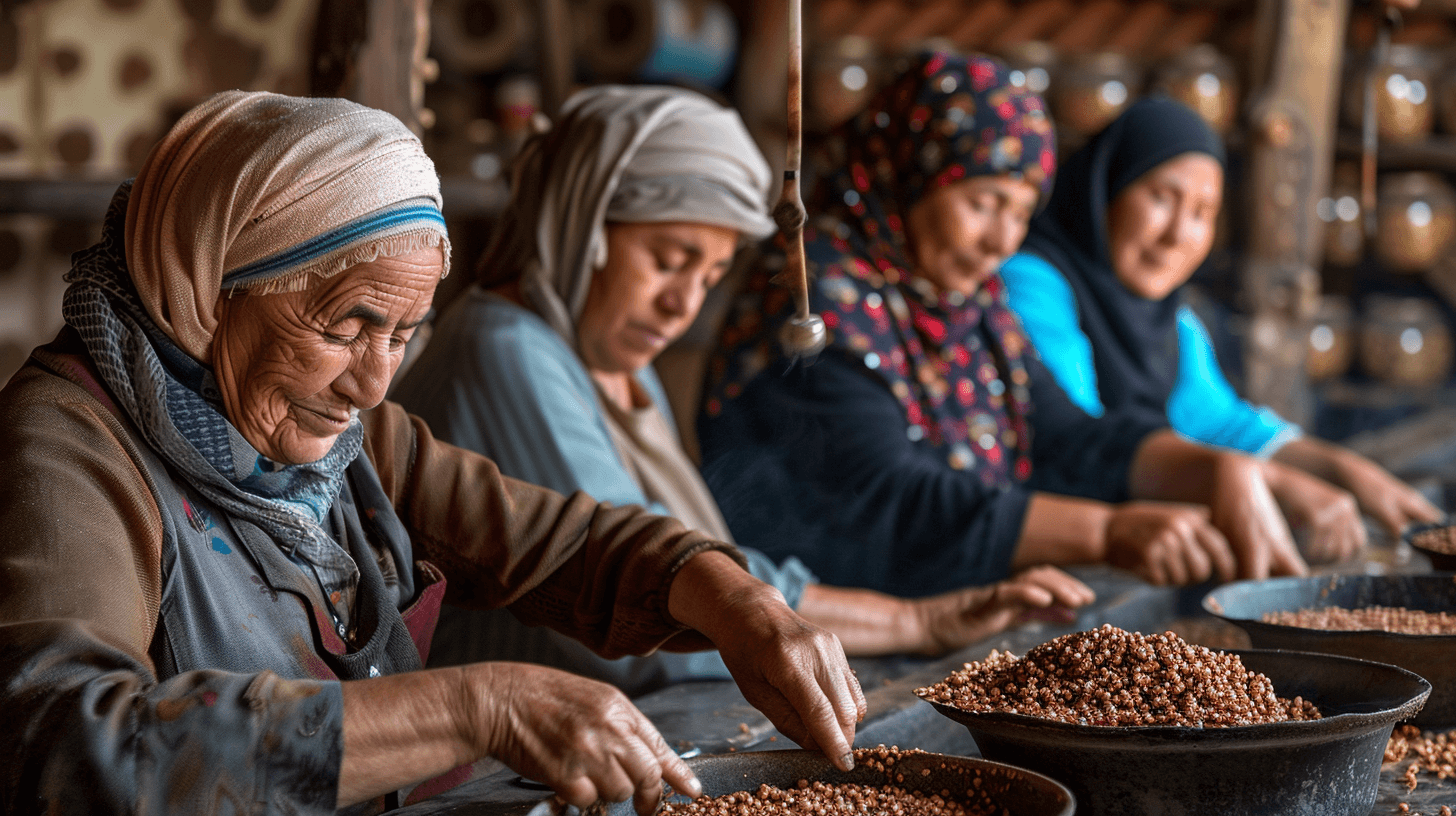 The labor-intensive process of Argan oil production relies heavily on the crucial role played by Berber women in collecting and processing the Argan nuts for oil. These women are an integral part of the production process, ensuring the authenticity, quality, and sustainability of the final product.
Argan oil, also known as “liquid gold,” is derived from the kernels of the Argan fruit, which are found in the Argan forests of Morocco. These forests are primarily managed by Berber communities, and it is the Berber women who possess the knowledge and expertise required for the labor-intensive task of harvesting and processing the Argan nuts.
The process begins with the collection of the Argan fruits from the trees. Berber women carefully handpick the fruits, ensuring that only the ripest ones are selected. This meticulous selection process is crucial to obtaining high-quality kernels, as unripe or damaged fruits may negatively impact the oil’s taste and aroma.
Once the Argan fruits have been collected, the Berber women then proceed to remove the outer pulp and dry the remaining kernels. This drying process is essential as it helps to reduce moisture content, ensuring the longevity of the kernels and preventing the growth of mold or bacteria.
After the kernels have been dried, they are cracked open by hand to extract the inner nut. This part of the process requires great skill and precision, as the Berber women must carefully crack the nuts without damaging the kernels inside.
Once the kernels have been extracted, they are then ground and pressed to extract the precious Argan oil. This traditional extraction method, which has been passed down through generations, allows the oil to retain its natural properties and ensures the production of high-quality oil.
Berber women’s involvement in the labor-intensive process of Argan oil production is not only crucial for obtaining authentic and high-quality oil but also plays a significant role in supporting the livelihoods of these communities. By recognizing the importance of labor in Argan oil production and supporting the efforts of Berber women, we can contribute to the preservation of this ancient tradition and the sustainable development of the Argan forests.
The labor-intensive process of Argan oil production relies heavily on the crucial role played by Berber women in collecting and processing the Argan nuts for oil. These women are an integral part of the production process, ensuring the authenticity, quality, and sustainability of the final product.
Argan oil, also known as “liquid gold,” is derived from the kernels of the Argan fruit, which are found in the Argan forests of Morocco. These forests are primarily managed by Berber communities, and it is the Berber women who possess the knowledge and expertise required for the labor-intensive task of harvesting and processing the Argan nuts.
The process begins with the collection of the Argan fruits from the trees. Berber women carefully handpick the fruits, ensuring that only the ripest ones are selected. This meticulous selection process is crucial to obtaining high-quality kernels, as unripe or damaged fruits may negatively impact the oil’s taste and aroma.
Once the Argan fruits have been collected, the Berber women then proceed to remove the outer pulp and dry the remaining kernels. This drying process is essential as it helps to reduce moisture content, ensuring the longevity of the kernels and preventing the growth of mold or bacteria.
After the kernels have been dried, they are cracked open by hand to extract the inner nut. This part of the process requires great skill and precision, as the Berber women must carefully crack the nuts without damaging the kernels inside.
Once the kernels have been extracted, they are then ground and pressed to extract the precious Argan oil. This traditional extraction method, which has been passed down through generations, allows the oil to retain its natural properties and ensures the production of high-quality oil.
Berber women’s involvement in the labor-intensive process of Argan oil production is not only crucial for obtaining authentic and high-quality oil but also plays a significant role in supporting the livelihoods of these communities. By recognizing the importance of labor in Argan oil production and supporting the efforts of Berber women, we can contribute to the preservation of this ancient tradition and the sustainable development of the Argan forests.
Labor Challenges in the Argan Forests
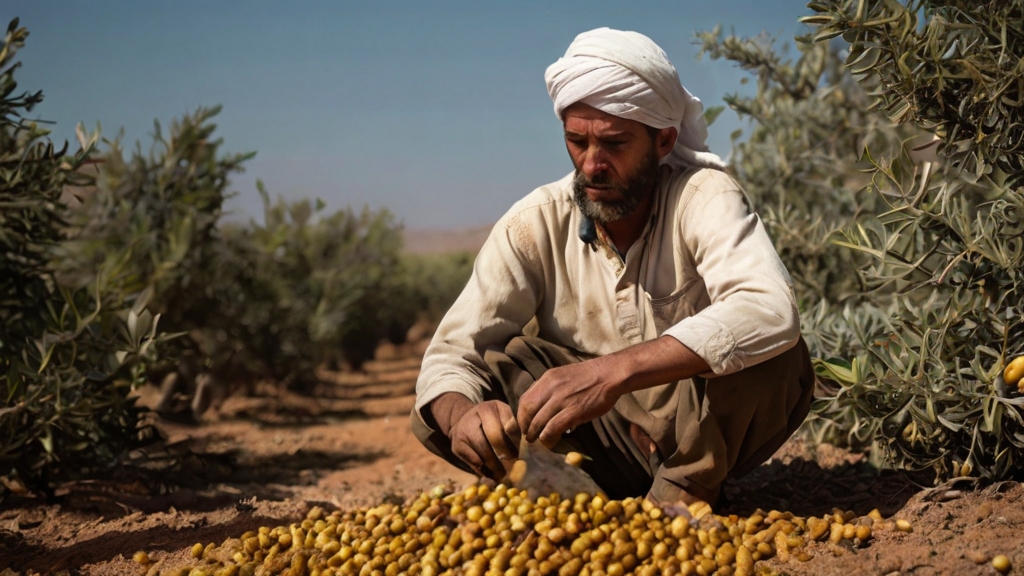 Labor challenges in the Argan forests revolve around two main factors: workforce shortage and the physical demands of the job. The rugged terrain and limited access for machinery make it difficult to mechanize the harvesting process, necessitating manual labor. Additionally, the task of climbing trees, gathering fruits, and transporting them for processing requires physical strength and endurance. These challenges highlight the need for a dedicated workforce and the importance of recognizing the efforts of the Berber women who predominantly perform this labor-intensive task.
Labor challenges in the Argan forests revolve around two main factors: workforce shortage and the physical demands of the job. The rugged terrain and limited access for machinery make it difficult to mechanize the harvesting process, necessitating manual labor. Additionally, the task of climbing trees, gathering fruits, and transporting them for processing requires physical strength and endurance. These challenges highlight the need for a dedicated workforce and the importance of recognizing the efforts of the Berber women who predominantly perform this labor-intensive task.
Workforce Shortage
Facing a challenging labor shortage, the Argan forest grapples with limited workforce availability and difficult work conditions in its quest to harvest Argan fruits for oil production. The manual labor required for harvesting Argan fruits has led to a migration of young people to urban areas in search of better opportunities. Traditionally, women in rural communities have shouldered much of the labor-intensive work in Argan oil production. However, the aging workforce in the Argan forests highlights the need for sustainable solutions to ensure the continued production of this valuable oil. Efforts are being made to address the labor shortage through training programs and community initiatives aimed at attracting and retaining workers.| Challenges | Impact | Solutions |
|---|---|---|
| Limited workforce availability | Decreased productivity and potential loss of revenue | Training programs to develop skilled laborers and attract younger generations |
| Difficult work conditions | Physical strain on workers and increased risk of injury | Improving work conditions and providing necessary safety equipment |
| Aging workforce | Decreased productivity and potential labor shortages | Community initiatives to encourage young people to stay and work in forests |
Physical Labor Demands
With the physical demands of harvesting Argan fruits and the labor challenges faced in the Argan forests, workers must exert significant effort to collect and process the fruits for oil production. Extracting Argan oil involves manual labor at every stage of the process. Berber women, the primary workforce in the Argan forests, face physical challenges as they climb trees or use ladders to reach higher branches for harvesting. The labor-intensive process includes hand-picking the fruits, extracting the kernels, and manually crushing them to obtain the oil. During the peak harvesting season, when large quantities of Argan fruits need to be processed, the physical demands are particularly high. The dedication and hard work of these individuals highlight their commitment to producing high-quality Argan oil through their tireless manual labor.Key Roles in the Argan Oil Harvesting Process
 When it comes to the key roles in the Argan oil harvesting process, Berber women are at the forefront. They are responsible for hand-picking the Argan fruits, drying them, and extracting the kernels. While men may assist in climbing trees or using tools, it is the women who lead the labor-intensive process.
When it comes to the key roles in the Argan oil harvesting process, Berber women are at the forefront. They are responsible for hand-picking the Argan fruits, drying them, and extracting the kernels. While men may assist in climbing trees or using tools, it is the women who lead the labor-intensive process.
Harvesting Techniques
Berber women play a crucial role in the Argan oil harvesting process, utilizing various techniques to hand-pick ripe Argan fruits from the trees. These fruits are the source of the precious Argan kernels, which are used to produce the oil. The women carefully climb the trees and selectively pluck the ripe fruits, ensuring that only the best ones are collected. This manual harvesting method ensures the quality of the fruits and protects the trees from damage. Additionally, mechanical harvesting methods are employed to increase efficiency and productivity. Goats also contribute to the process by consuming the Argan fruits and excreting the nuts. Once harvested, the Argan nuts are cleaned and processed to extract the oil-rich kernels, which are then used to produce the highly sought-after Argan oil.Labor Conditions
What are the key roles in the Argan oil harvesting process? The labor conditions in the Argan oil production highlight the traditional and communal nature of the process. Berber women play a crucial role in harvesting Argan fruits for oil extraction. They meticulously hand-pick the fruits from the Argan trees, ensuring only the ripe ones are collected. Men assist in climbing the trees and using tools to gather the Argan nuts. The labor-intensive tasks include extracting the kernels from the fruits, which require precision and skill. The harvesting process involves teamwork and coordination among community members, emphasizing the importance of collaboration and community support. The labor conditions reflect the dedication and expertise of the individuals involved in the Argan oil production, showcasing their commitment to preserving this cultural tradition.| Key Roles | Activities | |
|---|---|---|
| 1 | Berber women | Hand-picking ripe Argan fruits |
| 2 | Men | Assisting in climbing trees and gathering Argan nuts |
| 3 | Community members | Coordinating and supporting the harvesting process |
| 4 | Laborers | Extracting kernels from the fruits with skill and precision |
Techniques and Tools Used in Argan Fruit Harvesting
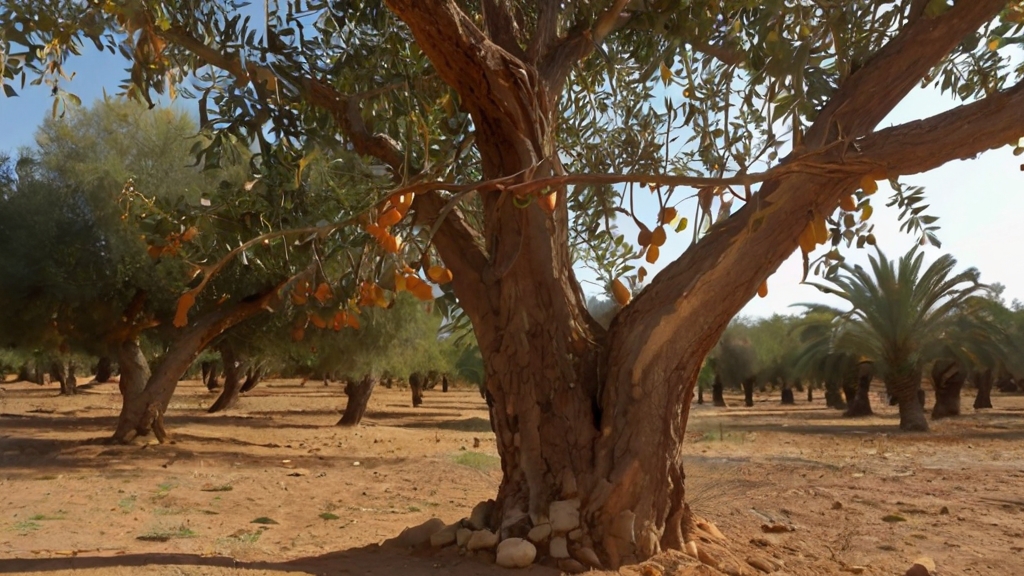 To efficiently collect ripe Argan fruits for oil extraction, Berber women traditionally employ a range of techniques and tools, ensuring careful selection and maintaining quality. These traditional methods have been passed down through generations, preserving the cultural heritage and sustainable practices of the local communities.
The first technique involves hand-picking the Argan fruits from the trees. Berber women use ladders to reach the branches and carefully select the ripe fruits. They also use sticks to gently shake the branches, causing the ripe fruits to fall into baskets or sacks. This method allows them to collect the fruits efficiently and avoid damaging the trees.
In some communities, goats are also relied upon to aid in the harvesting process. These goats are allowed to graze on the Argan trees, eating the fruits. Later, the undigested nuts are collected from their excrement. While this may seem unusual, it is an effective way of gathering the nuts without damaging the trees or wasting any resources.
Harvesting tools such as baskets and sacks are essential in gathering the Argan fruits and transporting them for further processing. The women carefully place the fruits in these containers to ensure they remain intact and undamaged during transportation.
The use of these traditional techniques and tools not only ensures the careful selection of ripe Argan fruits but also contributes to the sustainability of the Argan oil industry. By preserving these traditional methods, Berber women are able to maintain the quality of the fruits and uphold the cultural practices that have been a part of their communities for centuries.
To efficiently collect ripe Argan fruits for oil extraction, Berber women traditionally employ a range of techniques and tools, ensuring careful selection and maintaining quality. These traditional methods have been passed down through generations, preserving the cultural heritage and sustainable practices of the local communities.
The first technique involves hand-picking the Argan fruits from the trees. Berber women use ladders to reach the branches and carefully select the ripe fruits. They also use sticks to gently shake the branches, causing the ripe fruits to fall into baskets or sacks. This method allows them to collect the fruits efficiently and avoid damaging the trees.
In some communities, goats are also relied upon to aid in the harvesting process. These goats are allowed to graze on the Argan trees, eating the fruits. Later, the undigested nuts are collected from their excrement. While this may seem unusual, it is an effective way of gathering the nuts without damaging the trees or wasting any resources.
Harvesting tools such as baskets and sacks are essential in gathering the Argan fruits and transporting them for further processing. The women carefully place the fruits in these containers to ensure they remain intact and undamaged during transportation.
The use of these traditional techniques and tools not only ensures the careful selection of ripe Argan fruits but also contributes to the sustainability of the Argan oil industry. By preserving these traditional methods, Berber women are able to maintain the quality of the fruits and uphold the cultural practices that have been a part of their communities for centuries.
The Labor-intensive Process of Extracting Argan Oil
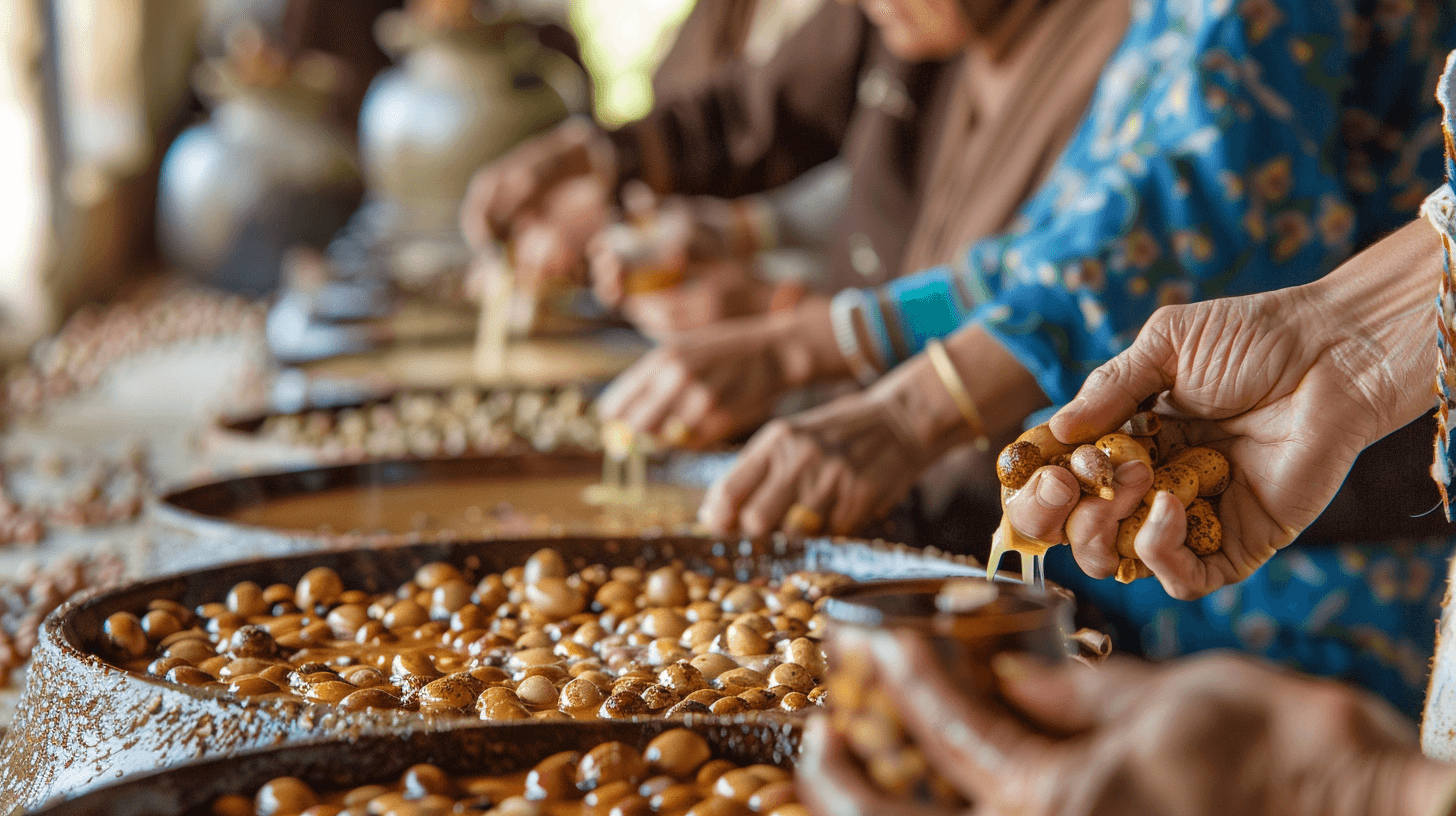 The extraction of Argan oil is a labor-intensive process that requires manual labor for harvesting, drying, and processing the kernels. Here are the key details about the labor-intensive process of extracting Argan oil:
The extraction of Argan oil is a labor-intensive process that requires manual labor for harvesting, drying, and processing the kernels. Here are the key details about the labor-intensive process of extracting Argan oil:
- Expertise and Dedication: Berber women, who have inherited the knowledge and skills from their ancestors, typically handle the extraction process. Their expertise and dedication are evident in the meticulous techniques they employ.
- Quantity and Yield: To produce just one liter of Argan oil, approximately 36 kg of Argan fruit is needed, which yields around 2.7 kg of kernels. This highlights the high volume of fruit required for oil extraction.
- Traditional Handcrafting: The traditional methods of extracting Argan oil involve time-consuming and meticulous handcrafting. Berber women crack open the Argan fruit to separate the kernels, which are then carefully roasted to enhance their flavor. They are then ground and pressed to extract the precious oil.
- Value of Traditional Practices: The labor-intensive process of extracting Argan oil emphasizes the value placed on traditional practices. The focus on maintaining these traditional techniques showcases the commitment to preserving the authenticity and quality of the oil.
Working Conditions and Fair Labor Practices in Argan Oil Production
 Working conditions and fair labor practices play a crucial role in ensuring the well-being and rights of the Berber women involved in the labor-intensive process of harvesting Argan fruits for oil production in Morocco. These women work tirelessly to extract the valuable oil from the hard shells of the Argan fruits, and it is important that they are provided with safe and fair working conditions.
In the Argan oil industry, some cooperatives prioritize the well-being of their laborers by providing them with proper tools and support. This includes tools such as protective gloves and masks to ensure their safety while working with the hard shells of the Argan fruits. Additionally, cooperatives may offer training programs to enhance their skills and knowledge in the extraction process, further ensuring their safety and efficiency.
Proper compensation and recognition of the hard work put in by these women are essential for sustainable and ethical Argan oil production. Fair labor practices in the industry involve ensuring that these women receive fair wages for their labor, as well as benefits such as access to healthcare and social security. Recognizing their contributions and empowering them economically not only benefits the women themselves, but also the local communities they belong to.
Transparency in labor practices and support for women’s empowerment are key aspects of fair labor in the Argan oil industry. By promoting transparency, consumers can make informed choices and support companies that prioritize fair labor practices. Additionally, initiatives that promote women’s empowerment, such as providing education and training opportunities, can help uplift the communities involved in Argan oil production.
Working conditions and fair labor practices play a crucial role in ensuring the well-being and rights of the Berber women involved in the labor-intensive process of harvesting Argan fruits for oil production in Morocco. These women work tirelessly to extract the valuable oil from the hard shells of the Argan fruits, and it is important that they are provided with safe and fair working conditions.
In the Argan oil industry, some cooperatives prioritize the well-being of their laborers by providing them with proper tools and support. This includes tools such as protective gloves and masks to ensure their safety while working with the hard shells of the Argan fruits. Additionally, cooperatives may offer training programs to enhance their skills and knowledge in the extraction process, further ensuring their safety and efficiency.
Proper compensation and recognition of the hard work put in by these women are essential for sustainable and ethical Argan oil production. Fair labor practices in the industry involve ensuring that these women receive fair wages for their labor, as well as benefits such as access to healthcare and social security. Recognizing their contributions and empowering them economically not only benefits the women themselves, but also the local communities they belong to.
Transparency in labor practices and support for women’s empowerment are key aspects of fair labor in the Argan oil industry. By promoting transparency, consumers can make informed choices and support companies that prioritize fair labor practices. Additionally, initiatives that promote women’s empowerment, such as providing education and training opportunities, can help uplift the communities involved in Argan oil production.
The Economic Impact of Argan Oil Harvesting on Local Communities
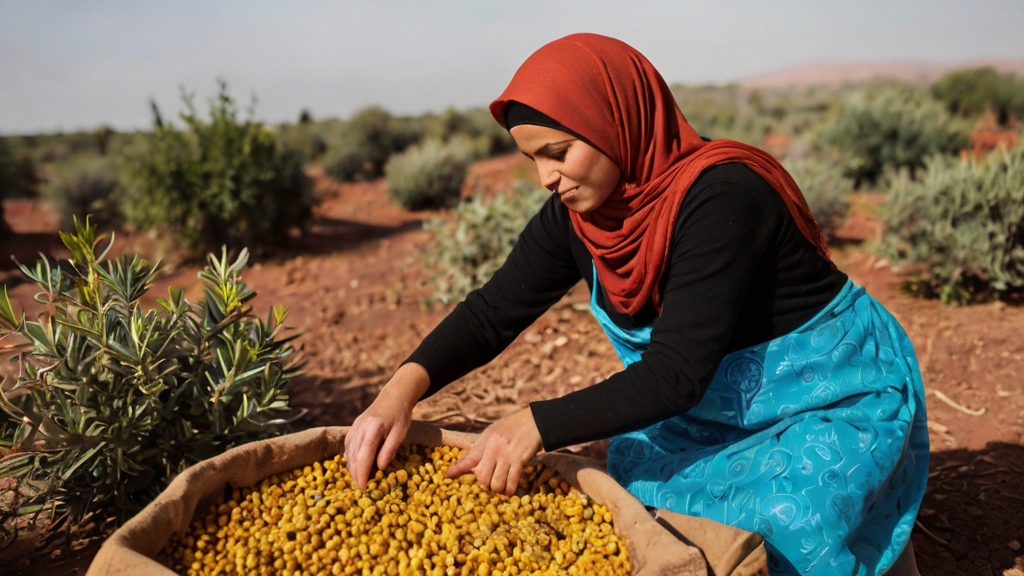 The harvesting of Argan oil in Morocco has a significant economic impact on local communities, providing income and employment opportunities while supporting sustainable development and poverty alleviation. The production of Argan oil involves a labor-intensive process of extracting the oil from Argan fruits, which is carried out using traditional methods that support rural livelihoods. Berber women, in particular, play a crucial role in the harvesting process and benefit economically from the production of Argan oil.
The economic impact of Argan oil harvesting extends beyond the individual women involved. The demand for Argan oil contributes to the economic growth and stability of the communities engaged in the harvest. This demand creates a sustainable market for the oil, ensuring a steady income for local residents. As a result, the production of Argan oil serves as a vital source of income for these communities, helping to lift them out of poverty.
Furthermore, the economic benefits of Argan oil harvesting go hand in hand with sustainable development. The process of extracting the oil from Argan fruits is done in an environmentally friendly manner, ensuring the preservation of the Argan forest ecosystem. This sustainable approach not only helps conserve the unique biodiversity of the region but also ensures the long-term viability of the Argan oil industry.
The harvesting of Argan oil in Morocco has a significant economic impact on local communities, providing income and employment opportunities while supporting sustainable development and poverty alleviation. The production of Argan oil involves a labor-intensive process of extracting the oil from Argan fruits, which is carried out using traditional methods that support rural livelihoods. Berber women, in particular, play a crucial role in the harvesting process and benefit economically from the production of Argan oil.
The economic impact of Argan oil harvesting extends beyond the individual women involved. The demand for Argan oil contributes to the economic growth and stability of the communities engaged in the harvest. This demand creates a sustainable market for the oil, ensuring a steady income for local residents. As a result, the production of Argan oil serves as a vital source of income for these communities, helping to lift them out of poverty.
Furthermore, the economic benefits of Argan oil harvesting go hand in hand with sustainable development. The process of extracting the oil from Argan fruits is done in an environmentally friendly manner, ensuring the preservation of the Argan forest ecosystem. This sustainable approach not only helps conserve the unique biodiversity of the region but also ensures the long-term viability of the Argan oil industry.
Frequently Asked Questions
How Is Argan Oil Harvested?
To harvest argan oil, you need to collect the oil-rich kernels from the fruits of the argan tree. You can do this by hand-picking the fruits or using ladders to reach higher branches. Some people even enlist the help of goats, who eat the fruits and spit out the kernels. After collecting the argan nuts, they are cleaned and processed to extract the valuable kernels. This is a crucial step in the production of argan oil, which is known for its benefits and popular uses.How Long Does It Take to Make Argan Oil?
Making argan oil involves a timeline that varies depending on the quantity needed. The process starts with roasting the kernels, which takes around 30 minutes for 2 kg. Then, grinding the roasted kernels can take about 2½ to 3 hours to extract the oil. Finally, it takes approximately 2 days to process ½-2 kg of argan nuts to produce 1 liter of oil. The efficiency of the extraction process depends on the labor and time invested in each step.What Are the Steps Involved in Extracting the Oil From the Argan Tree Kernels?
To extract oil from Argan tree kernels, the process involves drying, peeling, crushing, and pressing. Traditionally, Berber women hand-process the kernels, ensuring authenticity. The extracted kernels are then cold-pressed manually to obtain the precious Argan oil. However, modern techniques also exist, utilizing mechanical methods for pressing. These methods save time and effort but may sacrifice the traditional labor-intensive approach that guarantees the oil’s quality. So, the choice between traditional and modern methods depends on the desired outcome and the importance of preserving tradition.Does Argan Oil Only Grow in Morocco?
Yes, Argan oil is primarily produced in Morocco. The country has a unique climate and soil conditions that support the growth of Argan trees for oil production. This has made Morocco the main producer of Argan oil globally. The demand for Argan oil has increased in recent years, leading to the growth of the Argan oil market. However, the labor-intensive process of extracting the oil from the Argan tree kernels is a key factor in the production of Argan oil in Morocco.Related Articles
Argan Oil Production From Argania Spinosa
Kept under lock and key, the secrets of argan oil production from Argania spinosa reveal the hidden treasures of this legendary liquid gold.
Harvesting Argan for Organic Oil Production
Ponder the remarkable benefits and sustainable practices involved in harvesting argan for organic oil production, and discover the intriguing role of women and unique extraction methods.
Health Benefits of Pure Argan Oil
Jumpstart your health and discover the surprising benefits of pure argan oil, from glowing skin to potential cancer-fighting properties.


